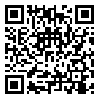1. Heidari F, Narimani M, Aghajani S, Basharpoor S. Causal modeling of conduct disorder signs based on childhood maltreatment and peer rejection with the mediating role of anger rumination: a descriptive study. The Journal of Rafsanjan University of Medical Sciences. 2022;21(4):377-96. [Persian] [
DOI]
2. Zarei E, Heydari H, Mahmoodi Nodaj M, Askari M, Mohammadi H. The role of attachment styles in predicting of conduct disorder among students. J Child Mental Health. 2015;1(1):67–75. [Persian] [
Article]
3. Yeniad N, Malda M, Mesman J, Van Ijzendoorn MH, Pieper S. Shifting ability predicts math and reading performance in children: a meta-analytical study. Learn Individ Dif. 2013;23:1–9. [
DOI]
4. Khodabakhshi-Koolaee A, Alizadeh F, Mansoor L, Pour-Ebrahim T, Falsafinejad MR. Perceived social support from family and friends and early maladaptive schemas among female and male delinquent and non-delinquent adolescents. Community Health. 2015;1(2):120–9. [Persian]
5. Martin R, Young J. Schema therapy. In KS Dobson; Editor. Handbook of cognitive-behavioral therapies. New York: Guilford Press; 2010.
6. Hanson RK. Empathy deficits of sexual offenders: a conceptual model. Journal of Sexual Aggression. 2003;9:13-23. [
DOI]
7. Mohammadpour S, Nazari H, Farhadi A. Predicting depression symptoms following childhood psychological maltreatment: the mediating role of early maladaptive schemas and difficulties in emotion regulation. J Mazandaran Univ Med Sci. 2016;26(136):85-98. [Persian] [
Article]
8. Flynn EB. Emotional and behavioral problems in development: the role of implicit theories of emotion [Thesis for MSc]. [California]: University of California, Irvine; 2016.
9. Hosseini FS, Karimi F, Nazpour M. The role of difficulty in emotion regulation and negative automatic thoughts in conflict resolution tactics of male high school students with parents. Research in Cognitive and Behavioral Sciences. 2018;8(1):77–94. [Persian] [
Article]
10. Hosaini FS, Karimi F, Nazarpour M. The role of difficulty in emotion regulation and negative automatic thoughts in Adolescent conflict resolution tactics with parents. Research in Cognitive and Behavioral Sciences. 2018;8(1):77-94. [Persian] [
DOI]
11. Kohls G, Baumann S, Gundlach M, Scharke W, Bernhard A, Martinelli A, et al. Investigating sex differences in emotion recognition, learning, and regulation among youths with conduct disorder. J Am Acad Child Adolesc Psychiatry. 2020;59(2):263–73. [
DOI]
12. Kleine Deters R, Naaijien J, Rosa M, Aggensteiner PM, Banaschewski T, Saam MC, et al. Executive functioning and emotion recognition in youth with oppositional defiant disorder and/or conduct disorder. World J Biol Psychiatry. 2020;21(7):539–51. [
DOI]
13. Krejcie RV, Morgan DW. Determining sample size for research activities. Educational and Psychological Measurement. 1970;30:607-10.
14. Achenbach TM, Rescolar LA. Manual for the ASEBA School – age forms and profiles. Burlington: ASEBA; 2001.
15. Young JE. Young Schema Questionnaire Short Form (1st ed.). New York: Cognitive Therapy Center; 1998.
16. Alimoradi B, Nejat H. Brain behavioral systems, early maladaptive schema, and premenstrual in mothers with postpartum depression disorder. Iranian Journal of Rehabilitation Research in Nursing. 2019;6(2):56-65. [Persian] [
Article]
17. Gratz KL, Roemer L. Multidimensional assessment of emotion regulation and dysregulation: development, factor structure, and initial validation of the Difficulties in Emotion Regulation Scale. J Psychopathol Behav Assess. 2004;26(1):41–54. [
DOI]
18. Heydariei A, Eqhbal F. Rabeteye doshvari dar tanzim hayajani, sabk haye delbastegi va samimiat ba rezayat zanashooei dar zojeyn sanaye foolad shahr Ahwaz [Evaluation of relationship between difficulty in emotion regulation, attachment styles and intimacy and marital satisfaction in couples of Ahwaz steel company]. Journal of Social Psychology. 2010;5(15):115–34. [Persian]
19. Minaee A. Adaptation and standardization of Child Behavior Checklist, Youth Self-report, and Teacher’s Report Forms. Journal of Exceptional Children. 2006;6(1):529-58.[Persian] [
Article]
20. Najafi M, Bitaraf M, Mohammadifar MA, Zarei Meteh Kalai E. The comparison of primary maladaptive schemas and cognitive insight between divorced and normal women. Quarterly Journal of Woman and Society. 2016;6(24):41-58. [Persian] [
Article]
21. Rezai Nasab F, Abbasi I, Naziri Q, Barzegar M. The determination of early maladaptive schemas in women with addictive relationships. Quarterly Journal of Woman and Society. 2013;4(2):83-109. [Persian] [
Article]
22. Gullotta R, Blau I. Intimate violence in families. Newbury Park, CA: Sage Publication; 2017.
23. Mohades N, Khanjani Z, Aqdasi AN. The effectiveness of mindfulness–based intervention on the emotion regulation difficulties components of students with conduct disorder. Journal of Instruction and Evaluation 2020;12(48):63–83. [Persian] [
Article]
24. Hayes SC, Luoma JB, Bond FW, Masuda A, Lillis J. Acceptance and commitment therapy: model, processes and outcomes. Behaviour Research and Therapy. 2006;44:1-25. [
DOI]

 ، یحیی یاراحمدی*1
، یحیی یاراحمدی*1 
 ، حمزه احمدیان1
، حمزه احمدیان1 
 ، مریم اکبری1
، مریم اکبری1 




